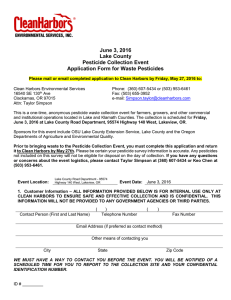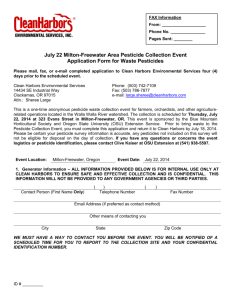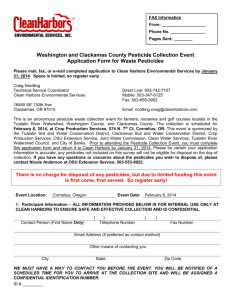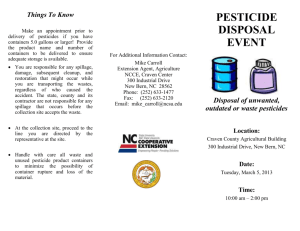Waste Collection Event Application Form for Conditionally Exempt
advertisement
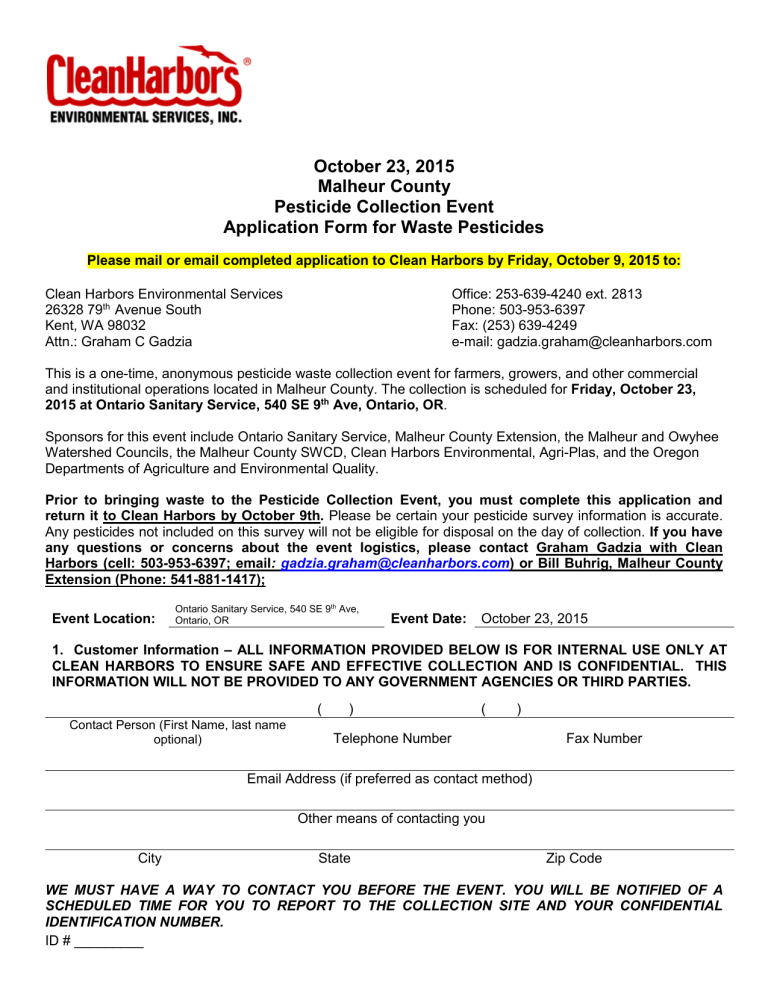
October 23, 2015 Malheur County Pesticide Collection Event Application Form for Waste Pesticides Please mail or email completed application to Clean Harbors by Friday, October 9, 2015 to: Clean Harbors Environmental Services 26328 79th Avenue South Kent, WA 98032 Attn.: Graham C Gadzia Office: 253-639-4240 ext. 2813 Phone: 503-953-6397 Fax: (253) 639-4249 e-mail: gadzia.graham@cleanharbors.com This is a one-time, anonymous pesticide waste collection event for farmers, growers, and other commercial and institutional operations located in Malheur County. The collection is scheduled for Friday, October 23, 2015 at Ontario Sanitary Service, 540 SE 9th Ave, Ontario, OR. Sponsors for this event include Ontario Sanitary Service, Malheur County Extension, the Malheur and Owyhee Watershed Councils, the Malheur County SWCD, Clean Harbors Environmental, Agri-Plas, and the Oregon Departments of Agriculture and Environmental Quality. Prior to bringing waste to the Pesticide Collection Event, you must complete this application and return it to Clean Harbors by October 9th. Please be certain your pesticide survey information is accurate. Any pesticides not included on this survey will not be eligible for disposal on the day of collection. If you have any questions or concerns about the event logistics, please contact Graham Gadzia with Clean Harbors (cell: 503-953-6397; email: gadzia.graham@cleanharbors.com) or Bill Buhrig, Malheur County Extension (Phone: 541-881-1417); Event Location: Ontario Sanitary Service, 540 SE 9th Ave, Ontario, OR Event Date: October 23, 2015 1. Customer Information – ALL INFORMATION PROVIDED BELOW IS FOR INTERNAL USE ONLY AT CLEAN HARBORS TO ENSURE SAFE AND EFFECTIVE COLLECTION AND IS CONFIDENTIAL. THIS INFORMATION WILL NOT BE PROVIDED TO ANY GOVERNMENT AGENCIES OR THIRD PARTIES. ( Contact Person (First Name, last name optional) ) ( ) Telephone Number Fax Number Email Address (if preferred as contact method) Other means of contacting you City State Zip Code WE MUST HAVE A WAY TO CONTACT YOU BEFORE THE EVENT. YOU WILL BE NOTIFIED OF A SCHEDULED TIME FOR YOU TO REPORT TO THE COLLECTION SITE AND YOUR CONFIDENTIAL IDENTIFICATION NUMBER. ID # _________ 2. Inventory of wastes you want to dispose of at this collection event Please complete the waste inventory sheet on the following page to list the wastes you will bring to the collection event. Make additional copies of the inventory sheet if needed. Return the completed inventory sheet(s) with this application. Instructions for completing the waste inventory sheet are included on the form. Only wastes that have been preregistered and approved by Clean Harbors Environmental Services will be accepted at the collection event. Radioactive materials, explosives, infectious medical wastes, certain poisons, and very reactive wastes are not accepted at these events. There is no quantity limit for collection of waste pesticides. Please provide adequate containment (e.g., place inside larger container) for leaking or degraded containers prior to transporting pesticide waste to the event. Unknown pesticides are accepted, but please describe the quantities and the physical state of the waste (liquid, solid, gas) on the registration form. Do the best you can to describe what you have! Tips for transporting pesticides to the collection event are provided at the end of this form. If you have trouble identifying the active ingredients in the pesticides you wish to dispose of please contact Graham Gadzia with Clean Harbors (cell: 503-953-6397; email: gadzia.graham@cleanharbors.com) Instructions for Completing Waste Inventory Sheet 1. Source: Please indicate whether the pesticides you are disposing of come from an active farm, a commercial applicator, or other operation. 2. Item Number: Number each item (or category group of items) you want to dispose of at the collection event. Each item should have an individual number on its container as reference. The container number should correspond to the completed inventory sheet(s) submitted. 3. Waste Description: Describe, in as much detail as possible, wastes that you want to dispose of at the collection event. The description should include the chemical and trade name, how you use the material, physical state (i.e., liquid, solid, sludge, gas), chemical characteristics (e.g., flammable/ignitable), and chemical constituents and percentages from the label or material safety data sheet (MSDS). For pesticides (e.g., herbicides, fungicides, rodenticides, etc.), please include the EPA registration number if available, trade name and percent concentration. When listing waste quantities, be as accurate as possible. DO NOT include wastes you do not want to dispose of at the collection event. Please avoid mixing your wastes together. 4. EPA Number: For pesticides (e.g., herbicides, fungicides, rodenticides, etc.), please include the EPA registration number if available, trade name and percent concentration. 5. Quantity: List the quantity of waste you want to dispose of at the collection event. As a rule, list liquids in gallons and solids in pounds. Please indicate the amount of product the container would potentially hold under container size and the amount that is remaining in the container under estimated quantity. Example: A 5-gallon bucket with one gallon of liquid remaining the container, please list 5 gallons under container size and 1 gal under estimated quantity. Most liquid pesticide containers are 2.5 gallons. Once Graham Gadzia, with Clean Harbors Environmental Services has received your registration application it will be reviewed for approval. You will receive a telephone call from Clean Harbors acknowledging acceptance of your application. The acknowledgment call will provide you with an appointment time for bringing in your waste, and any changes to the collection event site. It may take several days before you receive your call. ID # _________ Waste Inventory Sheet for Collection Event (Copy and use additional sheets if needed) Source: (Check appropriate box) Farm /Orchard Commercial Applicator Item # Waste Description Other: _____________________ EPA ID or USDA Numbers Formulation Type (check one) 1 Solid Liquid Other 2 Solid Liquid Other 3 Solid Liquid Other 4 Solid Liquid Other 5 Solid Liquid Other 6 Solid Liquid Other 7 Solid Liquid Other 8 Solid Liquid Other 9 Solid Liquid Other 10 Solid Liquid Other Waste Inventory Sheet -- Page ___ of ___ ID # _________ Number of Containers Container Size Estimated quantity Liquids in gal. Solid in Pound Waste Inventory Sheet for Collection Event (Copy and use additional sheets if needed) Source: (Check appropriate box) Farm /Orchard Commercial Applicator Item # Waste Description Other: _____________________ EPA ID or USDA Numbers Formulation Type (check one) 1 Solid Liquid Other 2 Solid Liquid Other 3 Solid Liquid Other 4 Solid Liquid Other 5 Solid Liquid Other 6 Solid Liquid Other 7 Solid Liquid Other 8 Solid Liquid Other 9 Solid Liquid Other 10 Solid Liquid Other Waste Inventory Sheet -- Page ___ of ___ ID # _________ Number of Containers Container Size Estimated quantity Liquids in gal. Solid in Pound Example Page Waste Inventory Sheet for Collection Event (Copy and use additional sheets if needed) Source: (Check appropriate box) Farm /Orchard Commercial Applicator Item # Waste Description Other: _____________________ Formulation Type (check one) Number of Containers Container Size 19713235 Solid Liquid Other 3 2.5 gal 7.5 Gal 510361085705 Solid Liquid Other 1 50 lbs Full 50 Pounds 4762133 Solid Liquid Other 2 30 lb bags, 3/4 full 45 Pounds left 895910 Solid Liquid Other 5 2x55gal 3x30gal 170 Gal Solid Liquid Other 12 Liter 12 Liters Solid Liquid Other 8 2.5 gal 20 gal Example 1 Captan 50W 48.9% n-Trichloromethylthio-4-cyclohexene-1, 2dicarboximide Example 2 Diazinon o-o-diethyl O-(2-isopropyl 6-methyl-4pyrimidinyl) phosphorothioate Example 3 Toxephene 40 WP Example 4 Cutrine Plus Example 5 Aerosol Cans Exmaple 6 Malathion 7 Solid Liquid Other 8 Solid Liquid Other 9 Solid Liquid Other 10 Solid Liquid Other ID # _________ Estimated quantity EPA ID or USDA Numbers Liquid in gal Solid in Pounds TRANSPORT TIPS No safety precautions and protective measures can be suggested that totally eliminate risks. However, here are some suggestions that may assist you in minimizing exposure as you work with waste pesticides. IF YOU HAVE A SPILL: CALL THE OREGON EMERGENCY RESPONSE SYSTEM (OERS) 1-800-452-0311 FOR EMERGENCY ASSISTANCE HANDLING WASTE MATERIAL: 1. Inspect containers. If, upon inspection, you have reason to suspect that the container will tear or rupture when moved, do not attempt to move or load the container for transport. Come to the collection site without it and we will provide assistance. 2. Wear the protective clothing and protective equipment (goggles, gloves, respirator, etc.) described on product labels when handling pesticides. 3. At a minimum, wear a long sleeved shirt buttoned at the wrist, a pair of chemical-resistant gloves, preferably a chemically resistant apron, rubber boots, goggles and a hat. 4. Have spill control materials available. For example, a 10-pound bag of commercially available safety absorbent, a shovel and a container for spilled material collected with the absorbent and contaminated soil may be useful in control and cleanup of a spill involving a small amount of material. Bring any spilled materials with you to the collection site for disposal. FOR TRANSPORTING WASTE MATERIALS: 1. Inspect all pesticides to see that they are securely packaged. Only transport containers that are securely closed. 2. Line the storage area of the transport vehicle with plastic sheeting to contain any spillage that might occur and therefore simplify cleanup and decontamination. 3. Assure all labels are securely attached. This is important for disposal of these materials. 4. Arrange containers in your vehicle so that they are braced to prevent shifting which may result in container damage and/or leakage. 5. All containers should be kept dry during transport. Loads in open vehicles such as pick-up trucks should be covered in the event of rainfall. 6. Do not transport pesticide waste in a manner that will allow fumes from those wastes to enter the passenger compartment of the transportation vehicle. DRIVE CAREFULLY. You are responsible for any spillage, damage, subsequent cleanup and restoration that might occur while you are transporting the wastes, whether the accident is your fault or other’s. The State and its contractor are not responsible for any spillage that occurs before the contractor at the collection site accepts the waste. ID # _________
